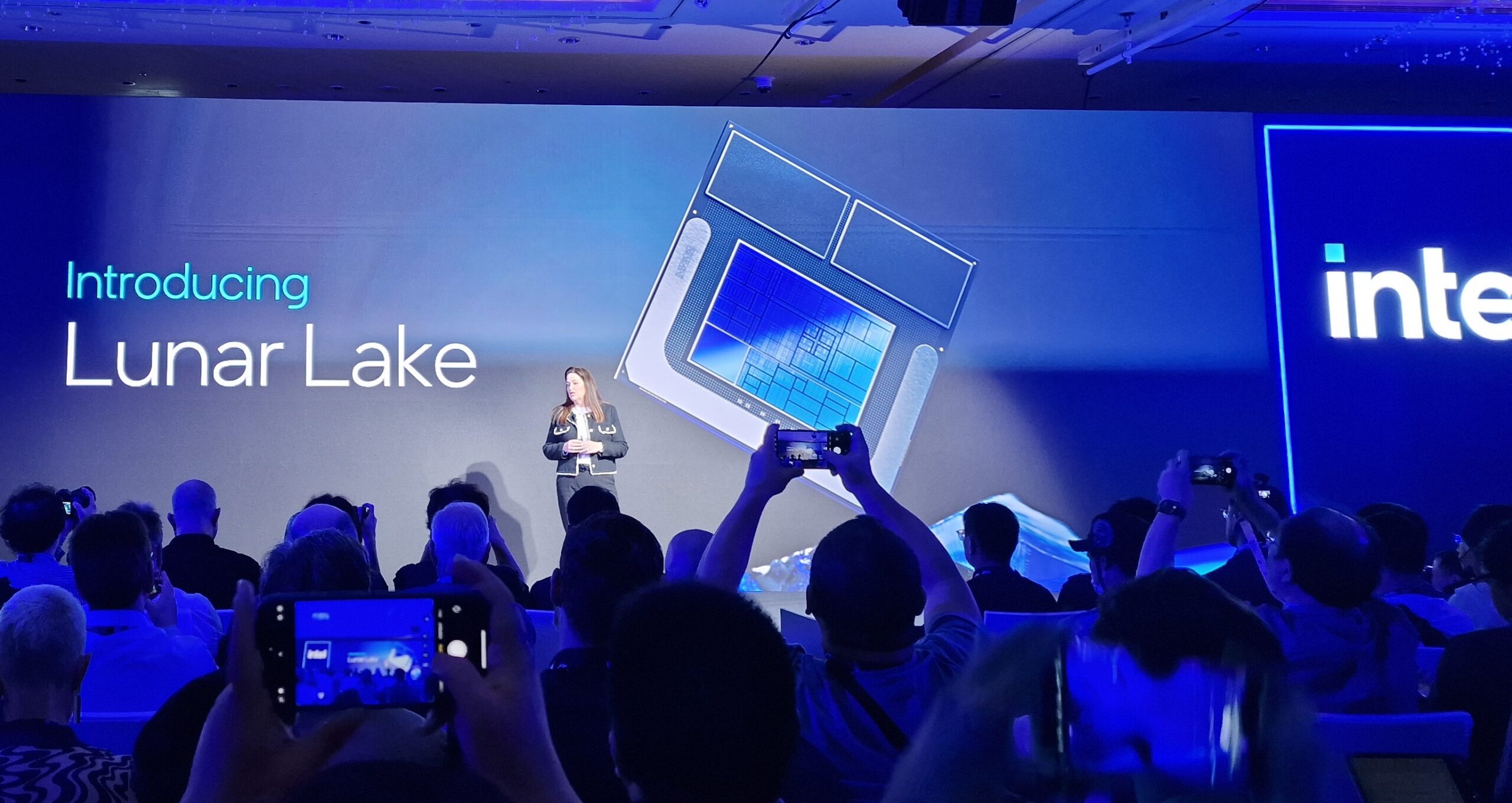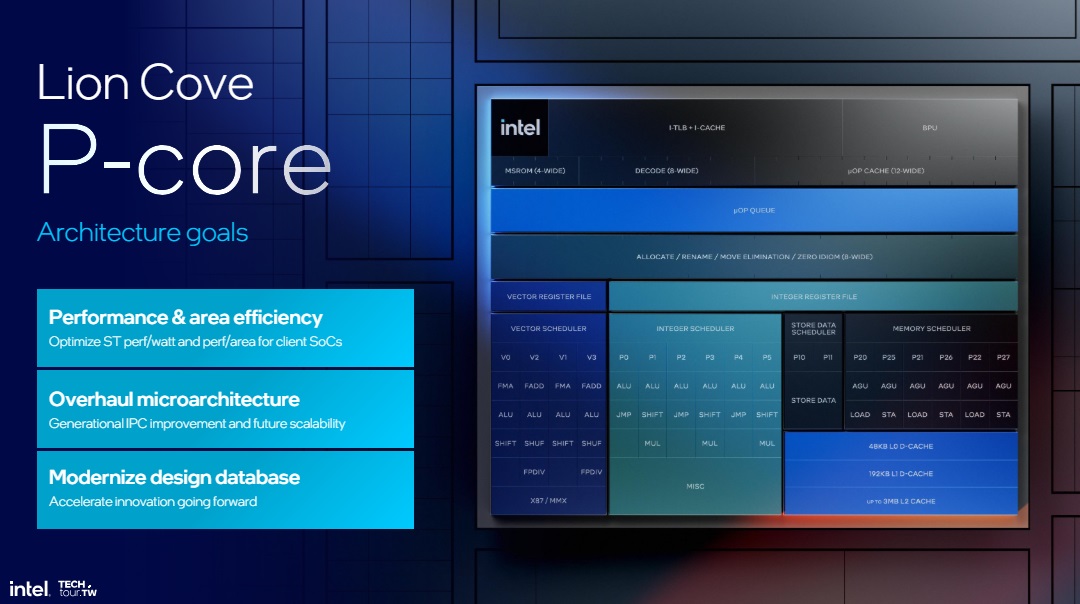Intel Lunar Lake Deep Dive – The Next Generation of AI PC
Everything you need to know about Lunar Lake
Ahead of Computex 2024, we were invited to take part in Intel’s “Tech Tour Taiwan” press event. While there, Intel gave us a deep dive into their new Lunar Lake SoCs, giving us a glimpse at the company’s next generation of AI PC chips. Through this experience we learned a lot about Intel’s newest chips, and the architectures that power it.
In short, everything has changed with Lunar Lake. We have new Performance Cores, we have new Efficient Cores, new integrated graphics, a new Neural Processing Unit, and more besides. Add on integrated WIFI 7, Thunderbolt 4, and more, and we have a mighty feature set for low power PCs. With Lunar Lake, Intel are proving that x86 can deliver breakthrough power efficiency, and that you don’t need an ARM CPU to create a great low power PC.
Intel’s Lunar Lake processors are only possible thanks to Intel’s advanced packaging technologies. Thanks to Intel’s Foveros technology, Intel can bring many smaller chips together to create a cohesive whole. Lunar Lake is the sum of many parts, and each of these parts are optimised individually to deliver the best performance and efficiency for users.
Memory on Package – Why it matters
Intel has created Lunar Lake to prove that x86 is the architecture for power efficient computing. While new ARM-based chip designs from Apple and Qualcomm are making waves, Intel knows that there is nothing stopping x86 CPUs from being just as efficient or more efficient than their ARM counterparts. Intel just needed to make more clever use of their resources.
With Lunar Lake, Intel are using a memory on package design. This means that the memory configurations of Lunar Lake CPUs are not upgradable. Even so, this design change enabled lower memory latencies, and lower memory power draw. Data no longer needs to travel longer distances, and that change has major power draw benefits.
Lunar Lake isn’t just about AI, it reworks Intel’s fundamentals
While a lot of the focus with Lunar Lake is on AI, Intel knows that they can’t just slap a some AI onto their newest chips and call it a day. Lunar Lake is designed to boost the performance of non-AI workloads, and that’s thanks to their new P-Cores and E-Cores.
With these new cores, Intel has focused on performance and area efficiency. Intel wants high levels of single-threaded performance while drawing relatively little power. They also wanted to modernise their CPU core designs to help increase their rate of innovation moving forward. Intel are kickstarting a new era with Lunar Lake, one where performance per watt is a larger focus.
With Lion Cove, Intel are changing their power management system. AI will be used to help get the most performance out of Intel’s cores. Clock speed intervals are now 16.67MHz instead of 100 MHz. These changes help Intel achieve more performance at any given power level. Add on their Lion Cove architectural improvements, and Lion Cove delivers major performance and efficiency gains over Redwood Cove.
When compared to Meteor Lake’s P-Cores, Intel claims to deliver 14% IPC gains. In performance/watt terms, Intel delivers gains of 10-18%. With Lion Cove, Intel are delivering more performance with less power.
Moving onto Intel’s E-cores, we have more significant changes. With Skymont, Intel wanted to deliver more performance with their E-cores while maintaining high levels of efficiency. This required a major redesign with Skymont, and that will have implications on both laptops and future desktops.
With Skymont, Intel has made their E-core designs more scalable, enhanced branch prediction, and have further parallelised their cores. Intel also boasts a 2x increase in AI throughput. Beyond that, Intel has ditched the dual Low-Power E-core configuration that Meteor Lake had. Now, there are no Low Power E-cores and separate E-cores. All E-cores are now the same, and all of them can operate at low power levels.
When compared to Intel’s Low-Power E-cores from Meteor Lake, Skymont promises users a staggering 68% increase in single-threaded Floating Point performance. When looking at single-threaded integer performance, Skymont delivers an impressive 38% boost.
Unlike Meteor Lake’s LP E-cores, Lunar Lake’s Skymont core clusters come with four cores. That means that Intel’s new E-cores can deliver major performance gains thanks to the addition of more cores and increases in single-threaded performance. Once again, Intel are delivering more performance, and they can do so while consuming less power. That said, Intel’s new E-cores can scale to higher power levels when the added performance is required.
Overall, Intel’s P-cores and E-cores are highly complimentary. Using Intel’s new Thread Director, they are optimising workloads to run at with the minimum power draw possible. That said, P-cores deliver scaling to higher performance levels when required, enabling a strong balance between power draw and power efficiency. Lunar Lake delivers full performance coverage while delivering the battery life gains that laptop users want. Who says x86 CPUs can’t be efficient?
Lunar Lake’s next-gen graphics – Meet Xe2
Intel has learnt a lot from their entry into the discrete GPU market. With Lunar Lake, we can now see the results of this learning. Xe2 has arrived, and with it comes more AI performance for Lunar Lake, and much stronger gaming performance.
While maintaining the same Xe Core count as Meteor Lake, Lunar Lake promises to deliver a 50% boost in gaming performance. Thanks to the addition of XMX units, Lunar Lake’s Xe2 GPU can also deliver up to 67 TOPS of AI performance. This also allows Lunar Lake to use the XMX accelerated version of XeSS. That enables faster, higher quality upscaling within supported games.
Again, the story with Lunar Lake is that Intel is delivering more performance at any given power level. Thanks to these gains with Xe2, Intel’s new Lunar Lake chips will be the CPUs behind the next generation of handheld gaming PCs. A 50% performance gains is a massive generational leap, and you can bet that handheld makers are looking at Lunar Lake with interest.
Alongside general GPU performance improvements, Lunar Lake brings to the table DisplayPort 2.1 support, VVC decoding, and improvements to the ray tracing performance of Intel’s integrated graphics. Xe2 deliver major gains for Intel in all areas, making us excited to see what Xe2 can do within the discrete GPU market. ARC Battlemage is coming!
Lunar Lake moves Intel into the AI PC era
With Lunar Lake, Intel is ready for the AI PC era with 48 TOPS of AI performance. This places Intel’s NPU ahead of Qualcomm’s latest Snapdragon SOCs, and when you add the AI performance of Intel’s CPU cores and Xe2 GPU, Lunar Lake has over 120 TOPS of AI performance available.
With 48 TOPS of NPU performance, Intel is ready to power Microsoft Copilot+ PCs. Yes, it will come to Snapdragon first, but only because Microsoft aren’t enabling it for x86 systems yet. Why are Microsoft pushing ARM so heavily? Who knows… It’s great to see a new competitor within the low power PC market. Even so, it is strange to see Microsoft not supporting Copilot+ on Intel and AMD NPUs on day-1. Really Microsoft?
With Lunar Lake, Microsoft are also adding support for PCIe 5.0 to their low power silicon. Thunderbolt 4 has been integrated in silicon, as has WIFI 7 and Bluetooth 5.4. This gives Intel’s Lunar Lake PCs access to a lot of advanced features without any extra chips of add-ons. That’s great for system integrators and end users.
Power Efficiency
The story of Lunar Lake is a simple on. Intel are offering more performance at lower power levels. x86 can be an efficient instruction set architecture, and Intel can deliver power efficient processors.
With Lunar Lake, Intel has delivered increased graphics performance, AI performance, and CPU performance. Every aspect of Intel’s new processors are better than their predecessors, making Lunar Lake a highly competitive offering. Intel is back! Let’s hope that they can keep this momentum going.
You can join the discussion on Intel’s Lunar Lake CPUs on the OC3D Forums.























